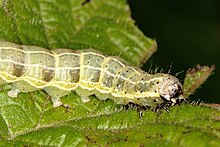Trapeze Owl
| Trapeze Owl | ||||||||||||
|---|---|---|---|---|---|---|---|---|---|---|---|---|

Trapeze Owl ( Cosmia trapezina ) |
||||||||||||
| Systematics | ||||||||||||
|
||||||||||||
| Scientific name | ||||||||||||
| Cosmia trapezina | ||||||||||||
| ( Linnaeus , 1758) |
The trapezium owl ( Cosmia trapezina ) is a butterfly ( moth ) from the family of the owl butterflies (Noctuidae). The caterpillars of the species are known in the literature as killer caterpillars , as they regularly attack and devour conspecifics under breeding conditions. In the wild, smaller caterpillars of other butterflies in particular fall victim to them.
features
Imago
The moths have a wingspan of 29 to 36 millimeters. The forewings have a basic color that ranges from yellow-gray, brown-gray to red-gray and brown-black. Sometimes the animals are covered in black dust. The drawing, on the other hand, is relatively constant. Inner and outer transverse lines are lighter, almost white, sometimes also lined with black. The inner transverse line runs almost straight from the inner to the front edge, while the outer transverse line has a broad sine. In contrast, the middle shadow and wavy line are often only hinted at; they are usually a little darker than the basic color. Ring and kidney flaws can be clearly highlighted with a light border, but they can also be barely visible if there is no border. The kidney defect has a black eye spot. The hemline is covered with black dots. The hind wings are uniformly gray, apart from the yellow fringes. The underside of both wings is also gray, the edges are yellowish. The outer transverse line is clearly highlighted on both wings; there is one discal spot in each case.
egg
The egg is hemispherical with clear, slightly wavy longitudinal lines. It is white and has a red band.
Caterpillar
The caterpillar is blue-green with a light, slightly darker back line. It is interrupted by the yellowish segment boundaries. The secondary back lines are also white. The light side stripe is bounded above by a dark zone. Another white longitudinal line is just above the legs. The point warts are black, often outlined in white, the stigmas are exclusively black. The head is yellow-green with an angular pattern.
Doll
The doll is light brown.
Way of life and occurrence
The trapezium owl is found mainly in forests, bushes, gardens and parks. It is widespread in Central Europe and usually quite common everywhere. The species forms one generation a year. The moths are nocturnal and often come to artificial light sources. They are easy to bait. The moths fly from mid-June to September. The eggs are laid on various deciduous trees. The egg hibernates. The caterpillars are polyphagous on willow ( Salix ), hornbeam ( Carpinus ), common hazel ( Corylus avellana ), birch ( Betula ), oak ( Quercus ), beech ( Fagus ), elm ( Ulmus ), pear ( Pyrus ), apples ( Malus ) . Hawthorn ( Crataegus ), Rubus , Roses ( Rosa ), Prunus , Sorbus , Maples ( Acer ), Linden ( Tilia ), Ash ( Fraxinus ), Dogwood ( Cornus ), Brown Spice ( Scrophularia ), Blueberries ( Vaccinium ) and Elder ( Sambucus ) . They also feed on animal food - such as the caterpillars of the little frost moth ( Operophtera brumata ), the autumn wire-haired owl ( Asteroscopus sphinx ) and the blue oak moth ( Quercusia quercus ) - and are therefore also known as murder caterpillars ; The caterpillars can be found mainly in May and June. They pupate in a web on the ground or between leaves.
distribution
The species occurs in almost all of Europe. In the north the distribution area extends to about central Fennoscandia, in the east to the Urals. The species is also found in North Africa, Asia Minor, Syria, Iraq, Iran, the Caucasus region across Central Asia to China, Korea and Japan. The species rises in the Alps up to 1600 m.
Systematics
The species was first introduced into scientific literature in 1758 by Carl von Linné under the name Phalaena Noctua trapezina . Later it was described under the following names: Phalaena rhombica Hufnagel, 1766, Calymnia badiofasciata Teich, 1883 and Calymnia trapezina var. Obscura Aurivillius, 1888. These names are more recent synonyms of Cosmia trapezina .
Danger
The species is very common everywhere and is not considered endangered.
literature
- Günter Ebert (Ed.): The butterflies of Baden-Württemberg, Volume 6, Nachtfalter IV. 622 S., Ulmer Verlag Stuttgart 1997 (Eulen (Noctuidae) 2nd part), ISBN 3-8001-3482-9 .
- Michael Fibiger and Hermann Hacker: Noctuidae Europaeae Volume 9 Amphipyrinae, Condicinae, Eriopinae, Xyleninae (part). 410 pp., Entomological Press, Sorø 2007 ISBN 87-89430-11-5 .
- Walter Forster , Theodor A. Wohlfahrt : The butterflies of Central Europe. Volume 4: Owls. (Noctuidae). Franckh'sche Verlagshandlung, Stuttgart 1971, ISBN 3-440-03752-5 .
Web links
- www.lepiforum.de Taxonomy and photos
- Markku Savela's Lepidoptera and some other life forms
- Moths and Butterflies of Europe and North Africa
- Cosmia trapezina at Fauna Europaea
- UK Moths by Ian Kimber

